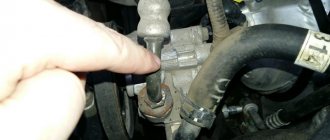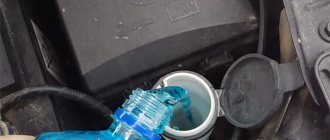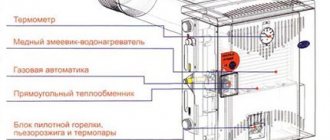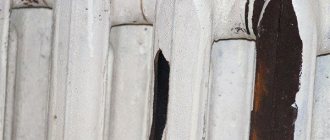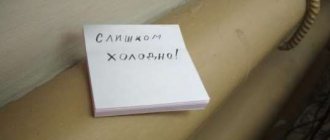Hello, friends. Today there is a lot of debate about what is better antifreeze or antifreeze? Many people believe that there is no difference, this is the name of the same substance. In fact, they are mistaken. These substances are different from each other. Those who do not understand this can harm the engine of their car. Now I will explain why.
Is it possible to fill with water?
In theory, water is no less effective in terms of heat transfer than antifreeze (both ethylene glycol and propylene glycol based). If you pour water into the cooling system, the engine will still operate normally and cool. Maybe the final temperature will be only 2 - 3 degrees higher, but there will not be a significant difference.
But only distilled water is allowed to be filled. In ordinary drinking or technical water there is too much admixture of salts and limestone, which is why scale forms. This sediment practically does not harm the metal, but it can lead to the formation of blockages in the radiator plates, which will deteriorate the cooling efficiency (and over time, microcracks will certainly form).
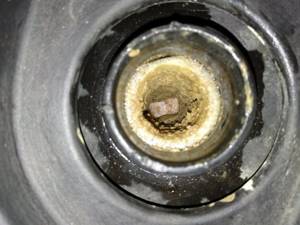
Accordingly, water instead of antifreeze can be used as a coolant, but for the “health” of the engine this is worse than using antifreeze that is not even of the best quality.
Disadvantages of water for use in the cooling system
Unlike antifreeze, water has the following disadvantages for its use as a coolant:
- provokes metal corrosion (the engine will simply begin to rust from the inside over time);
- does not have washing properties, which accelerates the wear of the circulating pump (the exception is systems with sealed bearings that do not come into contact with the coolant);
- has a lower boiling point (already at 85 degrees “funnels” begin to form, thereby interfering with the normal circulation of the liquid).
One more nuance: active operation of the car with water poured into the cooling system requires regular “topping up” of distilled water, since it simply boils away. And often air pockets can form with it, since in water, unlike antifreeze, a much larger volume of oxygen is “dissolved”. It is this that forms those very “funnels” during boiling. If there is an air lock, the normal circulation of the coolant is also disrupted; the pump simply stops pumping water (which also causes it to overheat).
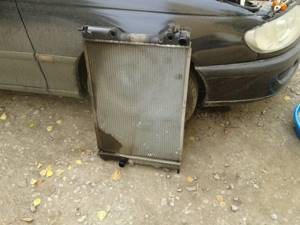
Also, water has a higher coefficient of volume change when changing temperature conditions. It is because of this that when refueling “up to the neck,” after the engine warms up, steam will definitely begin to ooze from the tank. And if the valve is also faulty, then the expansion tank can be completely damaged.
Is it possible to mix antifreeze with water?
Water instead of antifreeze is not the best option. Can antifreeze be mixed with water? Experts strongly advise against doing this. This option is allowed only for propylene glycol antifreeze with a crystallization temperature of around -65 degrees.
This composition can be diluted with distilled water in a ratio of 1 to 1 (in this case, the freezing point of the resulting coolant will be around -20 degrees). But it is also recommended to refrain from such mixing (the exception is if such procedures are allowed by the antifreeze manufacturer, as indicated in its instructions).
It is strictly forbidden to mix ethylene glycol antifreeze with water, since when its original chemical composition changes, it loses most of its properties (optimal viscosity, heat transfer, detergent properties, corrosion protection). And because of this, the foaming process is activated (it is not so easy to wash the cooling system of foam later).
Water deal: what happens if you mix poured antifreeze with water and a direct answer to the question
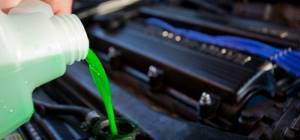
Experts warn that there is no need to rush; you need to look through the factory booklet for information about the filled emulsion and ways to restore its level. Then the question of what will happen if you mix antifreeze with water will disappear by itself. We will present multilateral situations when it is possible to add natural chemical liquid and when it is not.
A little fluid was lost
Let's say the nominal level in the tank has shifted down by 100...300 milliliters. In this case, you can confidently fill in water and not worry about the condition of the system. The balance of additives will not change, since the evaporated liquid is just water. It's worth knowing:
- Antifreeze is half water.
- Only distilled composition can be added.
- Ordinary water cannot be added due to the fact that the outcome of the interaction of the natural chemical composition with coolant additives is unknown.
- The solution from the tap is harsh and can lead to corrosion of the cooling system passages.
For your information. Many manufacturers sell concentrates. These products are precisely dissolved with distilled water. The proportions depend on the desired freezing temperature and are indicated on the packaging. The nominal ratio of diluted substances for temperate climates is 1:1.
Coolant is missing in large quantities
The best option would be to add ready-made antifreeze or diluted concentrate. If a leakage situation occurs far from points of sale, and it’s summer outside, then you can safely pour the distilled composition. As a last resort, filtered water will do.
If diluted with a large amount of water, the coolant must be replaced. Moreover, this should be done before the onset of the first cold weather. Naturally, in winter it is prohibited to resort to excessive dilution of the coolant. After all, it may freeze and the engine will require partial repairs.
Which antifreeze is better?
The main thing in antifreeze is the correct proportion of additives, which prevent corrosion, changes in the viscosity of the coolant, scale formation, and foaming. Therefore, you should simply use high-quality antifreeze from reputable manufacturers.
Which is better: propylene glycol or ethylene glycol? The difference between them in terms of performance characteristics is minimal. But propylene glycol is not produced in the Russian Federation, so it costs more.

So, is it possible to add water instead of antifreeze in the summer? Yes, the car will work normally. But the consequences of using such a coolant will definitely make themselves felt sooner or later. In the best case, scale will simply appear in the radiator; in the worst case, the corrosion process will be activated, which can only be stopped at an early stage by thoroughly flushing the engine cooling system.
It is not recommended to conduct such experiments; absolutely all car manufacturers indicate that it is necessary to use antifreeze (the brand is selected depending on environmental conditions).
Topic in the “Audi Repair” section, created by NoAccess, May 29, 2010.
You are using an outdated browser. This and other sites may not display correctly. You need to update your browser or try using a different one.
Cars with internal combustion engines require a cooling system that can be filled with any liquid: plain water, distilled water, antifreeze, antifreeze.
Differences between antifreeze and antifreeze.
Today, three types of coolants for internal combustion engines are used: water (distilled or pure rainwater), antifreeze and antifreeze.
Antifreeze is the name of the liquid (translated as “anti-freeze”) for the engine cooling system, which does not freeze and can withstand high temperatures.
Standard composition of antifreeze for cars:
- Water.
- Ethylene glycol.
- Glycerol.
- Alcohol.
- Acid salts or carbonate additives.
Composition of antifreeze:
- Water.
- Anti-corrosion additives.
- Burates and phosphates.
- Alcohols.
- Glycols.
- Nitrites.
- Silicates.
- Nitrates.
Differences:
- antifreeze was invented later than antifreeze;
- Antifreeze is better in terms of environmental friendliness;
- The boiling point of antifreeze is higher;
- The freezing point of antifreeze is lower;
- Antifreeze provides better protection against corrosion.
- Antifreeze forms a protective film, but antifreeze does not, and therefore antifreeze cools much more efficiently.
- The service life for which antifreeze is designed is 6 times less than that of antifreeze.
- antifreeze protects engine cylinder liners from cavitation (air bubbles).
- The service life of the pump (pump) is significantly reduced if antifreeze is used.
- antifreeze does not clog radiators, and various types of deposits do not form.
The main disadvantage of antifreeze is that when heated to 105 degrees, its properties deteriorate.
Antifreeze boils when heated to 115 degrees and does not leave sediment in the channels and can be used for up to 250,000 km.
In which cars should I use antifreeze, and where should I use antifreeze?
Against the background of the considered features of different types of coolants, the question arises of what is recommended to be used and in what case.
The first thing you should focus on when choosing is the make of the car and the manufacturer’s recommendations. The developers specify in the vehicle manual which consumables are best to use.
But these are only recommendations. In practice, the car enthusiast takes responsibility for the choice onto his own shoulders.
So which is better? Please note the following points:
- Antifreeze can be used on old domestic cars of the VAZ, Moskvich and other brands. For foreign cars, high-quality antifreeze is more suitable (reasons are described below).
- The use of antifreeze leads to a decrease in power, increased fuel consumption and rapid engine wear.
- Antifreeze is more loyal to aluminum engine elements. If you use antifreeze in cars with a radiator made of this metal, you will soon need to purchase a new unit.
- When using antifreeze, the service life of the water pump is reduced, the radiator and thermostat become dirty faster.
- Antifreeze does not have a detrimental effect on the rubber and plastic elements of the cooling system, which cannot be said about its “competitor”.
Also read - Is it possible to mix antifreeze of different colors, brands and manufacturers in a car.
What happens if you mix antifreeze with antifreeze?
Firstly, the question is why mix these two different refrigerants. Well, various circumstances happen on the road, for example, there is an antifreeze leak and after eliminating the leak, you need to add antifreeze. But there is not always a canister of antifreeze in the trunk, and here they sell antifreeze nearby on the side of the road. You have to buy it and top it up to continue moving forward.
Or, as often happens, sooner or later after buying a used car, you have to top up the coolant, and then the driver asks the question: what was filled in before? Color is easy to determine, but classes are difficult. In such cases, experts recommend, again, not to save, but to drain the old fluid and fill in the new one in full. It is even possible that the old one has expired.
Finding out whether it is possible to mix antifreeze of different brands and colors: recommendations from experts
Having discovered that there is not enough coolant in the expansion tank, it is worth asking what type of composition is filled. This may be specified in the instruction manual. It is quite possible that this information is printed on the container itself in the form of a sticker.

In general, the answer to the question whether it is possible to mix antifreeze of different colors is logical - it is possible if the types of coolant are the same. After all, color does not determine the composition of the coolant. In short, there are no standards for colors - this is a conventional designation adopted by the manufacturer, nothing more. For coloring, different companies can use their own pigment for the same type of antifreeze.
Is it possible to mix different brands of antifreeze?
Let's start with what classes of antifreeze there are. This:
Antifreeze G11 is a liquid of inorganic origin and contains silicates. Available in blue or green colors. Suitable for old cars.
Antifreeze G12 is a liquid of organic origin. Produced in pink and red flowers.
Antifreeze g11 and g12 what is the difference
The difference between antifreeze g11 and g12 is that inorganic G11 contains substances that protect against corrosion (inhibitors). Thanks to corrosion inhibitors, a film is created on parts and protects it from contact with oxygen, which causes the metal to rust. Antifreeze GI 11 is glycol-based, that is, if you do not add corrosion inhibitors, the aggressive glycol will begin to corrode metal parts. OX G11 must be changed at least once every 2-3 years. The common color of JI-11 is green. Green G11 is the lowest class.
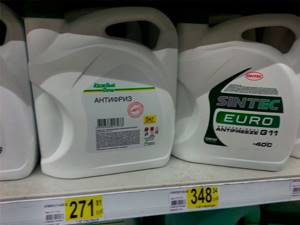
As for G12 class antifreezes, they are based on carbosilicates. Since many parts in an internal combustion engine are made of aluminum and steel, upon contact with liquids, destructive films are formed on their surfaces. The additives contained in GI 12 prevent the formation of a destructive film (the technology is called Long life). The substances in G12 do not form a protective film on all surfaces of channels and parts, but only where pockets of corrosion have appeared, in order to protect against further destruction of the metal. This class of antifreeze begins to boil at a temperature of 120 degrees. Service life 5 years.
G12 antifreeze can be poured into the engine cooling system only if the engine parts are not made of non-ferrous metals. Otherwise, the carboxylate liquid will corrode them.
You can and cannot mix:
- If the antifreeze contains one base, then you can mix it.
- Silicate-free antifreeze should not be mixed with others.
When mixing antifreeze of different classes and brands, a reaction of the additives occurs and precipitation appears, but not immediately, but after heating to the operating temperature of the engine. This means that these sediment particles will clog the radiator channels and settle on engine parts.
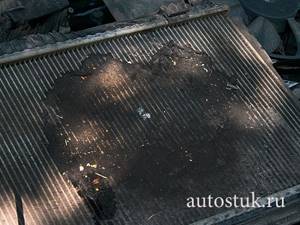
If you had to mix G11 and G12, then after that this mixture must be drained and the system flushed several times. These two classes should not be mixed.
G11 and G12 cannot be mixed. Even if you add just a little bit of 11 to 12, the 12th will lose its properties.
G12 and G12+ can be mixed, but you shouldn’t. Although they have the same base, manufacturers could add different additives that will react with each other. With the index + it only means that it is new generation. Service life 5 years or 250 thousand km.
G13 is a new class of liquid for the internal combustion engine cooling system. The main antifreeze composition is propylene glycol (for G11,12,12+ ethylene glycol). It is more expensive, but more environmentally friendly and contains fewer poisons. Used in powerful engines of sports cars and motorcycles.
Adviсe
Almost all manufacturers allow mixing different solutions as a temporary measure. But then, in order to avoid sedimentation and other undesirable phenomena, it is better to drain all the antifreeze. MAN recommends cleaning in three steps. First, the system is washed with a 60% solution of a new concentrated solution. Then they take 10 percent, and complete the procedure by pouring it mixed in equal proportions with water.
Scania experts recommend adding coolant with water and a corrosion inhibitor. All necessary information can be obtained from the technical documentation of a specific manufacturer. If a brand of solution not prescribed in the manual is used, any manufacturer will void the warranty on the vehicle.
Using a neutral cleaning agent, which is poured in as an additive, will save time. With it you don’t have to worry about flushing; it cleans the channels while the car is in use. Moreover, the substance dissolves contaminants to a liquid state without precipitation that can clog the radiator tubes. It is believed that the use of such products is the best option, since neutral ones cause less harm to the engine.
When replacing or adding coolant, car owners are faced with a dilemma - is it possible to mix antifreeze with antifreeze, and what is the difference between these compositions.
There is a lot of debate on the Internet about the features of red, blue or green coolant.
Also, car enthusiasts do not always know what the differences are between the G11 and G12 series antifreezes, and what will happen if they are mixed. Let's look at these questions in more detail.
Is it possible to mix antifreeze with water?
Since antifreeze contains a significant amount of water, if you add water to antifreeze, nothing bad will happen. Dilution simply occurs and concentration decreases. The more water you add, the worse the antifreeze properties will become.
But sometimes it is recommended to add water to antifreeze. This approach is used when antifreeze has boiled, causing water to evaporate and the remaining liquid in the cooling system to become highly concentrated. But when adding, you need to know the proportions. Excessive amounts of water will cause rust to appear in the cooling system.
Attention: mixing water with antifreeze is only possible in summer. At sub-zero temperatures, such diluted coolant can quickly seize and freeze.
If such antifreeze freezes, you will have to invest in repairs in the car components. Usually, when the coolant freezes, the radiator of the stove and engine ruptures, as well as pipes burst and hoses crack.
Even if the antifreeze was boiling and it became highly concentrated, it is better to add antifreeze of the same class and brand. In winter, it is safer to operate the car with high concentration antifreeze.
The conclusion about adding water to antifreeze is this: if you had to add water, then add a little.
When adding antifreeze, add only antifreeze of the same class that was added previously (G11, G12, G12+, G13) and the same color. Antifreeze class G-13 is based on propylene glycol.
conclusions
There is no need to worry about what will happen if you mix any antifreeze with water. Half of the coolant consists of natural chemical composition. The rest is additives and ethylene glycol or propylene glycol alcohol. So the answer suggests itself - you can add water to the coolant, but only distilled or, in extreme cases, filtered.
But do not abuse the amount of water - no more than 300 ml. Otherwise, the freezing temperature of the mixture will change not for the better. Of course, there is a way out in this case as well - in winter you can cover the car radiator with insulation or fabric.
You can mix antifreeze of different colors, but only if they are of the same brand. There are no generally accepted standards for the color of solutions. Different manufacturers may have the same class of coolant painted in different colors.
According to the recommendations of representatives of the automakers themselves, antifreeze (antifreeze) must be poured into the engine cooling system. Its key property is that it does not freeze at subzero ambient temperatures, so in winter there is no need to drain it while the car is idle. It turns out that in the summer it is permissible to use ordinary water instead of antifreeze? Or should this not be done?
Antifreeze and water can be mixed
Antifreeze contains the same elements: water and ethylene glycol. Antifreeze was invented in the USSR in 1971.
Classification of antifreeze by type:
- A - ready to be poured into the car’s cooling system.
- M - modernized, that is, it contains additional components.
- K is a highly concentrated liquid, it will have to be diluted.
After the letters, which are divided by type, write 2 numbers - subzero temperature, at which the antifreeze will not freeze. For example, M40, or M65.
The color of good antifreeze is between blue and light blue; there is also a greenish color. Antifreeze brand A65 is red. Legal in Russia, GOST 28084-89 distributes three types of OZh-K, OZh-40, OZh-65. If there are no coolant (coolant) designations, there is only a GOST number, then it is a fake.
How to drain antifreeze
If it is clear that the answer to the question of whether antifreeze can be added to antifreeze is more negative than positive, it is better to know in advance how to change the substance. According to the manufacturers' recommendations, replacement should be done regularly. During operation, it becomes contaminated, loses its properties, and turns into black slurry.
There is usually a drain plug near the bottom corner of the radiator. Draining occurs through it. In other models, you have to disconnect the pipes attached to the radiator and pour out the waste. The machine must be on a horizontal surface or on an overpass. For a better process, you can place the car at a slight angle. A basin is placed under the car to collect antifreeze and cans with lids are prepared into which the waste will be poured for further disposal. Before the procedure, you must turn off the engine and wait until it cools down. Otherwise, you may get burned by hot steam.
But you can’t immediately pour in a new substance. Due to the design features of the radiator, a certain amount of contaminated liquid remains inside, and there is always sediment on the walls. Therefore, it is important to clean the cooling system. To do this, tighten the drain plug and open the top valve intended for filling. There are several types of contaminants in the cooling system, so ideally you need to use two products: to remove contaminants - with an acidic reaction from scale and corrosion, and also an alkaline one, which removes antifreeze decomposition products.
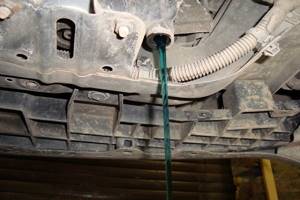
It is convenient to use a special two-component washing kit. First, you will need to pour the first reagent into the tank, close the top valve and warm up the engine. Then open the drain lid and drain the waste. Then clean in the same way using a second reagent. For best results, it is recommended that after using the flush, clean the system several times with distilled water.
Consequences of mixing antifreeze and antifreeze.
If antifreeze and antifreeze are successfully mixed, that is, when you are lucky, the main components of the composition of both liquids are the same, then there will be no formation of sediment and clogging of channels. But, it is very difficult to know the composition of both liquids.
If the bases of these liquids are different, then when adding antifreeze to antifreeze or antifreeze to antifreeze, the liquid may immediately become cloudy and with sediment, or this will happen after natural heating of the engine or using engine preheating.
Is it possible to mix antifreeze with antifreeze and what will come of it?
Since both fluids consist of different elements, mixing domestic and imported coolant is prohibited. Refrigerants differ from each other not only in additives, boiling and freezing temperatures, but also in the degree of aggression towards car components. And as we know, antifreeze itself is a very aggressive substance. During the connection, a chemical reaction may occur, leading to coagulation and precipitation, clogging the ducts of the system. Clogged channels will lead to:
- to the occurrence of piston rings and to engine overheating;
- thermostat with bearing failure;
- pump a fails ;
- deformation of the cylinder head or engine block.
In addition, when mixing antifreeze and antifreeze, foaming is possible, which is extremely undesirable, as this can lead to freezing of the antifreeze or also overheating of the engine. In addition to the above, severe corrosion can occur that will simply eat up the system. In general, it should be noted that modern vehicles have a determining system, which, in the event of a mismatch of fluid in the expansion tank, simply does not allow the engine to start. Also, many people think that even if the antifreeze is multi-colored, but from the same manufacturer, it can be mixed. This is misleading, as they may differ in chemical additives. Let us repeat that color does not add chemical properties, it is simply a dye. Each manufacturer can make its own shade of the main color.
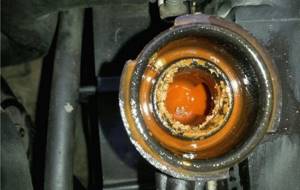
The consequences of mixing antifreeze and antifreeze
Any coolant has a brand, it is indicated in small letters on the packaging, because the color does not play a special role. To understand what kind of liquid is in front of you, you need to look for the G11 or G12 markings. Antifreezes under these standards cannot be mixed. It is permissible to combine if the base and additive package are completely identical. When the coolant is selected correctly, the engine temperature will not drop, and the cooling system will operate at the proper level. But many people get confused because there are exceptions. Below are the conditions when mixing different refrigerants is possible:
- G11 can be mixed with G11 analogues;
- G11 can be mixed with G12+;
- G11 can be mixed with G12++;
- G11 can be mixed with G13;
- G12 can be mixed with G12 analogues;
- G12 can be mixed with G12+;
- G12+, G12++ and G13 can be mixed with each other.
In general, if a driver wants to switch to another antifreeze, this is not done abruptly; the old coolant must first be drained, and the entire system must be thoroughly washed - the cylinder block, radiator and expansion tank.
